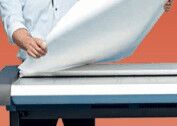What is the Best File Format for Scanning Construction Documents?

Introduction
Up until recent decades, construction drawings were created, archived, and distributed in paper. In this day and age, it is universally accepted that paper is no longer the best way for archiving or distributing construction drawings. Furthermore, while most new building design is done in CAD, it is also true that distributing original CAD design documents is impractical, due to their large file sizes and the inability to protect the original work when it exists as a CAD drawing.

For construction companies who have paper archives, the question becomes: Which file format is the best choice when we scan our paper documents for archive purposes?
Electronic File Formats – Three Alternatives
Group 4 TIFF/CALS, PDF, and DWF are considered industry standards for construction file scanning, archiving, and distribution.
Group 4 TIFF is an ‘open’ industry-standard raster* format that was designed by CCITT as a general monochromatic format for use in the copying and facsimile industry where compactness and image versatility are primary considerations. Group 4 TIFF is part of the TIFF format which has several different variants using different compression techniques. Group 4 is widely used in the reprographic industry and employs a very efficient compression capability. Group 4 TIFF stores information and performs compression in a uniform way.
The CALS file format is a US government-accepted variant of the Group 4 TIFF specification, specifically developed and supported as an archival standard within the government. CALS is almost identical to Group 4 TIFF except for header information.
PDF is a proprietary file format controlled exclusively by Adobe Systems. It is commonly used to convert disparate word processing and graphics application files into a document format that can only be viewed with the PDF viewer called Acrobat. A PDF document may contain multiple pages and can consist of both text, graphics, and images. PDF files may also contain

hyperlinks. PDF files can be composite structures that contain multiple format types and compression techniques.
Most large format scanners will also enable scanning construction documents to the raster TIFF/CALs or PDF format. However, because DWF is a vector format, the scanned raster document would need to be converted to DWF as a separate process.
Differences between Raster and Vector File Formats
It should be noted that vector-based file formats such as DWF store endpoints of drawings while raster-based documents such as TIFF or CALS store graphics in a grid at a resolution of a specific number of dots per inch. Large-format scanners produce only raster files.
File Size Comparisons
There is no formula or ratio that provides a direct comparison between file format types regarding file size. However, in general, the original CAD file will always be the largest (expressed in MBs), while the TIFF, CALS, and PDF will nearly always be expressed in KBs. So, for instance, a 1.62 MB CAD could become a 13 KB TIFF or CALS file or a 24 KB PDF. The file size is always dependent upon the complexity of the drawing and the attributes within it. Even in the example above, it is taken from one specific file that cannot be interpolated into a rational formula applicable to all drawings and files.
Security of Paper in an Electronic File

Design professionals generally feel most comfortable with the distribution of TIFF or CALS because these file types provide the greatest amount of ‘original work’ protection. DWF is less favored because DWF documents can be readily imported into a CAD system– thus, DWF files do not provide sufficient ‘original work’ protection TIFF/CALS cannot be easily imported into a vector format and therefore is much better suited for public distribution.
Therefore, when scanning construction documents for archiving or distribution, TIFF/CALS is the most favored file type. For organizations that want to bring one or more of their archives into their CAD system, a file conversion process is done after the scanning enables the conversion of the raster file into a CAD vector file.
Recent Posts


Tips for Picking the Perfect 3D CAD Viewer for Your Needs
This guide will teach you about 3D CAD viewers and outline considerations to make before picking the right one. We review 5 options and pick a clear winner.

In this guide, you’ll learn how CAD/CAM Services can save you time and money during each digitization project. Digitization can make manufacturing faster than ever before.

How to Build an Aircraft Model by Converting 3D-Scanned STL Files into Functional 3D STEP Files
This in-depth guide will teach engineers how to use 3D-scanned aircraft files and transform them into manufacturable 3D STEP files with fewer mistakes.
